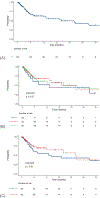Outcomes After Palliative Radiation Therapy in Patients With Symptomatic Locoregionally Advanced Breast Cancer
- PMID: 39549757
- PMCID: PMC12172089
- DOI: 10.1016/j.ijrobp.2024.11.065
Outcomes After Palliative Radiation Therapy in Patients With Symptomatic Locoregionally Advanced Breast Cancer
Abstract
Purpose: Symptomatic locoregionally advanced breast cancer (SLABC) can cause troublesome pain or wound complications that negatively impact quality of life. Although palliative radiation therapy (RT) can minimize tumor-related symptoms, how best to tailor RT to achieve the most meaningful and durable response is not well defined.
Methods and materials: This is a single institution, multi-site retrospective review of patients with SLABC treated between 2016 and 2023 with palliative RT to symptomatic disease in the breast, chest wall, and/or regional lymph node basins. Overall survival (OS), locoregional control (LC), clinical and radiographic treatment response, overall pain scores, and treatment-related toxicities were analyzed.
Results: A total of 164 patients with a median age of 57 years were analyzed with a median follow-up time of 4.97 months. In total, 86% had distant metastases. The most common presenting symptom was pain (87%), followed by ulcerating or fungating lesion (76%) and discharge (45%). The median cumulative biologically effective dose to the gross tumor volume (BEDGTV) was 69 Gy. The 1-year OS and LC rates were 37% and 63%, respectively. Eighty-one percent experienced improvement in symptoms within 3 months after RT, the odds of which increased per Gy BEDGTV (odds ratio, 1.029; P = .003). Acute toxicities were associated with number of fractions and BEDGTV (both P < .001), but not with concurrent systemic therapy or reirradiation (both P > .05). Trends in pain scores showed a significant change in pain trajectory that was sustained during the first year after RT. OS and LC were not different among patients who received 1 versus 2 to 10 versus >10 fractions, and between ≤70 and >70 Gy BEDGTV.
Conclusions: In this large series of patients with SLABC, palliative RT was effective at relieving locoregional symptoms with acceptable toxicity, with the likelihood of symptom improvement associated with radiation dose. Survival of these patients remains poor, highlighting the importance of palliative care strategies that minimize overall symptom burden while maximizing quality of life.
Copyright © 2024 Elsevier Inc. All rights reserved.
Figures



References
-
- International Agency for Research on Cancer . Cancer today. Accessed May 25, 2024. https://gco.iarc.who.int.
-
- Webb K, Gothard L, Mohammed K, Kirby AM, Locke I, Somaiah N. Locoregional control and toxicity following high-dose hypofractionated and accelerated palliative radiotherapy regimens in breast cancer. Clin Oncol (R Coll Radiol) 2023;35:e469–e477. - PubMed
-
- Yee C, Alayed Y, Drost L, et al. Radiotherapy for patients with unresected locally advanced breast cancer. Ann Palliat Med 2018;7:373–384. - PubMed
-
- Chatterjee S, Chakrabarty S, Santosham R, et al. Alleviating morbidity from locally advanced breast cancer using a practical and short radiation therapy regimen: Results of the HYPORT palliative studies. Int J Radiat Oncol Biol Phys 2023;116:1033–1042. - PubMed
Publication types
MeSH terms
Grants and funding
LinkOut - more resources
Full Text Sources
Medical

